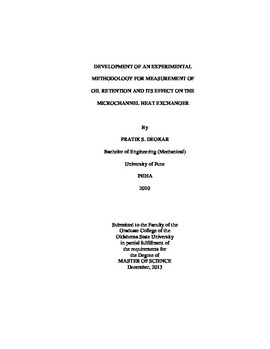| dc.description.abstract | In HVAC and refrigeration systems, the lubricant is used only because the compressor requires it for lubrication and sealing. A small portion of the oil circulates with the refrigerant flow through the cycle components, while most of the oil stays in the compressor. The circulating oil, which is missing from the compressor, can form a fairly homogeneous mixture with the liquid refrigerant or it can exist as a separate oil film inside the small tubes and headers of a microchannel heat exchanger. Each heat exchanger in the refrigeration cycle has different oil retention characteristics, and large amounts of oil retention cause a change in heat transfer and an increase in pressure drop. As a result, proper oil management is necessary in order to improve the compressor reliability, to increase overall efficiency of the system, and to minimize system cost by avoiding redundancy and wasted energy. The thesis focuses on developing methodologies for oil retention experiments on the microchannel heat exchanger working as a condenser and adopted in systems for commercial refrigeration and air conditioning applications. An experimental test facility is designed, built, and calibrated for injecting the oil into a microchannel heat exchanger in a controlled fashion. The methodologies allow accurate measurements of the oil circulation ratio (OCR), heat transfer penalty factor (HTPF), and pressure drop penalty factor (PDPF) under different operating conditions. The oil retained in the microchannel heat exchanger can also be measured. The refrigerant in this work is R-410A and the oil used is ISO VG 32 grade Mixed Acid POE. The microchannel heat exchanger can also be tested as an evaporator in the same test facility by making minor modifications to the fluid circuitry. A total of five levels of oil circulation ratios are investigated: OCR = 0, 0.5, 1, 3, and 5 percent by weight. The tests are done at the refrigerant flow rates of 400 lb/h (0.05 kg/s) and 600 lb/h (0.076 kg/s), and at the refrigerant (R-410A) saturation temperatures of 85�F (29.4�C), 105�F (40.6�C), and 130�F (54.4�C). The data for the HTPFs, PDPFs and oil retentions are provided as a function of OCRs, refrigerant flow rates, and refrigerant saturation temperatures to prove the effectiveness of the methodology. | |
